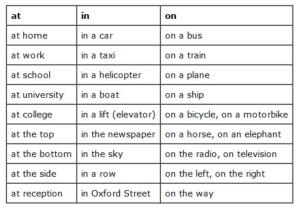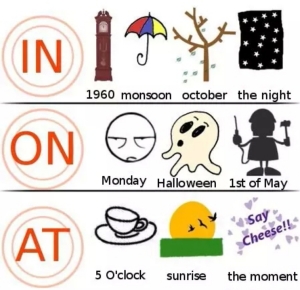In my day-to-day teaching I find that choosing the correct preposition is one of the most common areas of difficulty for ESL students. They often make mistakes because they assume that they can translate the preposition used in their own language into its equivalent in English. For example, an Indonesian student might say or write “Her dress looks similar with her sister’s” (Bajunya mirip dengan baju milik saudara perempuannya. ‘dengan’ = ‘with’), not knowing that in English she/he should write “Her dress looks similar to her sister’s” (similar to = sama dengan, NOT similar with).

The same mistake happened with the sign above. The sign should say “No smoking in this area”, NOT “No smoking on this area”.
How to talk about locations?

One of the most confusing grammar points for English learners is trying to figure out whether to use AT, ON, or IN when you talk about locations and places. I hope after reading this explanation, you will no longer be confused.
When do I use IN?
Use the preposition IN when you are talking about something that you can physically enter or that you can place something inside of such as:
• I am standing in the room (I can enter a room)
• I put the chicken in the oven
• My wallet is in my pocket.
• How long did you live in Jakarta?
When do I use AT?
You should use AT when you want to indicate a specific location or place.
For example:
• We wait for bus number 39 at the bus stop
• I buy my groceries at the farmer’s market
• Turn left at the end of the block
• Please wait at my desk if you want to speak with me.
• The teacher asked the students to sit at their own desk.
Remember you “sit at the desk” and not “sit on the desk”
— “sit at the desk” means you sit on the chair near the desk and “sit on the desk” means you sit on top of it.
When do I use ON?
We use ON when we want to say that something is resting on a vertical or horizontal surface.
We can say:
• We sat on the bench
• I put the poster on the wall
• Put your feet on the floor
• Drive one mile and store will be on your left.
• What’s on the menu?
How to talk about time?

This is an easy way to remember the prepositions of TIME:
• AT is for small times
at 2 pm; at the moment; at that time; at lunchtime; at midnight; at midday
• ON is for days:
on May 30; on Thursday morning; on New Year’s Eve; on weekdays
• IN isfor big times:
in 2014; in December; in the winter; in my life; in the 18th century
I hope you will understand the use of at – on – in as prepositions of place and time after reading my explanation in this section. Leave me a reply should you need more explanation on this subject.

Send me more comman errors and learning tips like prepositions,phrase.etc
LikeLike
Sharif Yar: I will. Just wait and see. You might like to check my English page on Facebook as well. You’ll find the lessons you’re requesting there. Click on the “Photo” and choose the album photo. Thank you for visiting my blog.
LikeLike
Yeah! Sometimes they are often make me confused when I want to use it. But thank you so much for the lesson, Miss Demi ^_^
LikeLike
Rul, you’re welcome.
LikeLike
plx could you explain difference between about and regarding?
LikeLiked by 1 person
could you plz explain the difference between about and regarding?
LikeLiked by 1 person
Parray Saleem, both the words ‘about’ and ‘regarding’ are prepositions that mean concerning.
The two words are often interchangeable:
“I have to make myself clear regarding this matter.”
“I have to make myself clear about this matter.”
‘Regarding, sounds more formal than ‘about’.
LikeLike
I got it well now thanks !
LikeLiked by 1 person
You’re welcome, anayisse rimane.
LikeLike